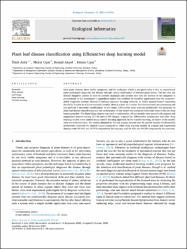| dc.contributor.author | Atilla, Ümit | |
| dc.contributor.author | Uçar, Murat | |
| dc.contributor.author | Akyol, Kemal | |
| dc.contributor.author | Uçar, Emine | |
| dc.date.accessioned | 2021-06-11T08:36:54Z | |
| dc.date.available | 2021-06-11T08:36:54Z | |
| dc.date.issued | 2021 | en_US |
| dc.identifier.citation | Atila, Ü., Uçar, M., Akyol, K., Uçar, E. (2021). Plant leaf disease classification using EfficientNet deep learning model. Ecological Informatics, 61, art. no. 101182.
https://doi.org/10.1016/j.ecoinf.2020.101182 | en_US |
| dc.identifier.uri | https://doi.org/10.1016/j.ecoinf.2020.101182 | |
| dc.identifier.uri | https://hdl.handle.net/20.500.12508/1754 | |
| dc.description.abstract | Most plant diseases show visible symptoms, and the technique which is accepted today is that an experienced plant pathologist diagnoses the disease through optical observation of infected plant leaves. The fact that the disease diagnosis process is slow to perform manually and another fact that the success of the diagnosis is proportional to the pathologist's capabilities makes this problem an excellent application area for computer aided diagnostic systems. Instead of classical machine learning methods, in which manual feature extraction should be flawless to achieve successful results, there is a need for a model that does not need pre-processing and can perform a successful classification. In this study, EfficientNet deep learning architecture was proposed in plant leaf disease classification and the performance of this model was compared with other state-of-the-art deep learning models. The PlantVillage dataset was used to train models. All the models were trained with original and augmented datasets having 55,448 and 61,486 images, respectively. EfficientNet architecture and other deep learning models were trained using transfer learning approach. In the transfer learning, all layers of the models were set to be trainable. The results obtained in the test dataset showed that B5 and B4 models of EfficientNet architecture achieved the highest values compared to other deep learning models in original and augmented datasets with 99.91% and 99.97% respectively for accuracy and 98.42% and 99.39% respectively for precision. | en_US |
| dc.language.iso | eng | en_US |
| dc.publisher | Elsevier | en_US |
| dc.relation.isversionof | 10.1016/j.ecoinf.2020.101182 | en_US |
| dc.rights | info:eu-repo/semantics/openAccess | en_US |
| dc.subject | Plant disease | en_US |
| dc.subject | Leaf image | en_US |
| dc.subject | Deep learning | en_US |
| dc.subject | Transfer learning | en_US |
| dc.subject.classification | Object Detection | |
| dc.subject.classification | CNN | |
| dc.subject.classification | IOU | |
| dc.subject.classification | Ecology | |
| dc.subject.other | Classification | |
| dc.subject.other | Computer aided design | |
| dc.subject.other | Data processing | |
| dc.subject.other | Infectious disease | |
| dc.subject.other | Machine learning | |
| dc.subject.other | Performance assessment | |
| dc.subject.other | Symptom | |
| dc.title | Plant leaf disease classification using EfficientNet deep learning model | en_US |
| dc.type | article | en_US |
| dc.relation.journal | Ecological Informatics | en_US |
| dc.contributor.department | İşletme ve Yönetim Bilimleri Fakültesi -- Yönetim Bilişim Sistemleri Bölümü | en_US |
| dc.relation.publicationcategory | Makale - Uluslararası Hakemli Dergi - Kurum Öğretim Elemanı | en_US |
| dc.contributor.isteauthor | Uçar, Murat | |
| dc.contributor.isteauthor | Uçar, Emine | |
| dc.relation.index | Web of Science - Scopus | en_US |
| dc.relation.index | Web of Science Core Collection - Science Citation Index Expanded | |
















